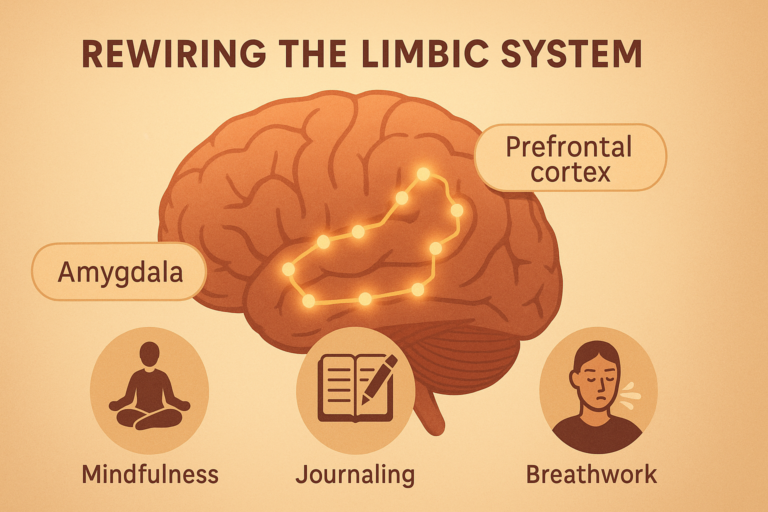Is Your Nervous System Overmedicated or Under Supported?

Written by Scott Pringle, Founder of the Integrated Health Foundation
- Published on August 1st, 2025
- If you prefer not to read the article or have screen sensitivity, you may listen to this audio version

Table of Contents
- Understanding the Overactive Nervous System
- The Science Behind the Overactive Nervous System
- Historical Context: How Did We Get Here?
- The Problem With Relying Only on Medications
- What’s Really Causing Nervous System Overactivity?
- How Do People Actually Heal?
- The Limbic System: The Control Room You Can Rewire
- The Gut: The Second Brain You Can Heal
- How to Do It Safely
- Common Questions About Healing an Overactive Nervous System
- Final Thoughts: Are You Ready to Stop the Merry-Go-Round?
Understanding the Overactive Nervous System
We all know someone, maybe it’s you, who’s been told, “It’s just anxiety, take these pills and calm down.” Meanwhile, your heart races when you stand, your hands shake when you hold a cup, you can’t sleep, and bright lights or sudden noises feel like personal attacks.
Sound familiar? Let’s get something straight: an overactive nervous system is not “just anxiety.” It’s a real, measurable state of your body stuck in survival mode. And most people living with dysautonomia, POTS, MCAS, or chronic stress have never been given a real road map to calm it down at the root.
So what is an overactive nervous system? In plain English, it’s your autonomic nervous system, the branch that runs everything automatic: your heart rate, blood pressure, digestion, temperature, stuck with the gas pedal jammed down. The sympathetic system (“fight or flight”) is on, but the parasympathetic (“rest and digest”) is off. And if you think a handful of pills alone will fix that wiring? Think again.

The Science Behind the Overactive Nervous System
We’re wired to survive. When your brain senses threat, real or imagined, it signals your body to pump out adrenaline, cortisol, and other stress chemicals. This helps if you’re running from a tiger. But what if the alarm system glitches? Now normal daily life feels like constant danger.
Studies show people with conditions like POTS and dysautonomia have measurable autonomic dysfunction. For example, a study in Autonomic Neuroscience (Raj, 2021) explains that POTS patients often show excessive sympathetic activation and poor vagal tone . Translation: their body’s stress switch won’t shut off.
Another review in Frontiers in Neuroscience (Thayer & Lane, 2009) highlights how trauma and chronic stress can reshape the brain’s limbic system, the amygdala and hippocampus, to stay on high alert . This means your brain literally rewires itself to expect threat, even when there isn’t any.
Historical Context: How Did We Get Here?

The modern answer to this ancient problem? Pills. Lots of them. Beta-blockers to slow your heart. SSRIs to calm your mind. Gabapentin to numb nerve signals. Clonidine to push down adrenaline.
But here’s the catch: none of these were designed to fix the underlying reason your system is stuck on high alert. They only muffle the fire alarm, they don’t put out the fire.
Before the pharmaceutical era, the focus was on rebuilding the body’s resilience, good food, rest, social support, and treating the whole person. That wisdom didn’t disappear. It just got buried under the next prescription pad.
The Problem With Relying Only on Medications
Beta-blockers like propranolol, metoprolol, or atenolol can slow your heart rate, true. Calcium channel blockers like amlodipine can help with blood pressure swings. SSRIs like Zoloft or Lexapro can dampen anxiety.
But no pill fixes a misfiring limbic system or an inflamed gut. And the data backs this up. A systematic review in Current Neuropharmacology (Baldwin et al., 2011) shows that while SSRIs help some anxiety symptoms, their impact on autonomic function is limited and withdrawal can worsen symptoms .
Long-term polypharmacy, being on multiple drugs at once, is now common. Many POTS or dysautonomia patients juggle 3–6 meds at a time. Some people take 10+. Each drug brings side effects: fatigue, dizziness, insomnia, digestive problems, brain fog. The symptom list gets longer, not shorter.
We all know someone, maybe it’s you, who’s been told, “It’s just anxiety, take these pills and calm down.” Meanwhile, your heart races when you stand, your hands shake when you hold a cup, you can’t sleep, and bright lights or sudden noises feel like personal attacks.
Sound familiar? Let’s get something straight: an overactive nervous system is not “just anxiety.” It’s a real, measurable state of your body stuck in survival mode. And most people living with dysautonomia, POTS, MCAS, or chronic stress have never been given a real road map to calm it down at the root.
So what is an overactive nervous system? In plain English, it’s your autonomic nervous system, the branch that runs everything automatic: your heart rate, blood pressure, digestion, temperature, stuck with the gas pedal jammed down. The sympathetic system (“fight or flight”) is on, but the parasympathetic (“rest and digest”) is off. And if you think a handful of pills alone will fix that wiring? Think again.
What’s Really Causing Nervous System Overactivity?
If pills can’t fix it all, what can? To reverse the chaos, you have to understand what’s driving it.
- Limbic System Hijack
Your brain’s threat detector, the amygdala, gets rewired by chronic stress, trauma, or prolonged illness. This keeps you stuck in hyper-vigilance. A 2007 meta-analysis in Neuroscience & Biobehavioral Reviews (Etkin & Wager, 2007) found increased amygdala activation in people with anxiety disorders, a clear sign that the brain’s fear circuit is in overdrive. - Gut-Brain Axis Dysfunction
90% of your body’s serotonin, the “feel good” neurotransmitter, is made in the gut. An unhealthy gut microbiome can produce excess histamine, trigger inflammation, and misfire stress signals up the vagus nerve. Studies in Nature Reviews Gastroenterology & Hepatology (Cryan et al., 2019) confirm that gut dysbiosis contributes to anxiety and autonomic disorders through cytokine pathways and vagal nerve signaling . - Nutrient Depletion
High stress and poor digestion drain magnesium, B vitamins, amino acids, the raw materials needed to make calming neurotransmitters. If you’re short on the building blocks, no pill can fill that gap for you.
How Do People Actually Heal?
This is the question most clinics don’t answer. We do. Because we’ve done it ourselves.
Healing an overactive nervous system is not about fighting symptoms, it’s about teaching the body it’s safe again.
The Limbic System: The Control Room You Can Rewire

Limbic retraining means you actively retrain the brain’s fear circuits. Tools like gratitude journaling, mindfulness, breathwork, or DNRS (Dynamic Neural Retraining System) have shown real promise.
One study in Psychiatry Research (Hölzel et al., 2011) found that mindfulness meditation reduced amygdala activity and increased prefrontal cortex regulation, exactly what a nervous system in overdrive needs.
When the limbic system calms, the autonomic system follows.
The Gut: The Second Brain You Can Heal
A balanced gut microbiome quiets inflammation and stabilizes neurotransmitter production. For people with POTS, MCAS, or IBS, gut repair can mean the difference between constant panic and calm.
This means removing inflammatory foods, fixing hidden infections, supporting digestion with enzymes and stomach acid, and sometimes targeted probiotics. Research published in Frontiers in Psychiatry (Rea et al., 2020) links gut microbial balance to reduced anxiety, improved sleep, and normalized stress hormone levels .
How to Do It Safely
If you want to heal your overactive nervous system, it’s not about going rogue or throwing out your prescriptions overnight. It’s about building a safer foundation, step by step, with a practitioner who understands the whole picture.
Key steps:
- Keep working with your trusted providers
- Don’t stop meds abruptly
- Add daily limbic system retraining
- Repair gut health, nutrient-dense food, fewer triggers
- Rebuild nutrients, magnesium, B vitamins, amino acids
- Track your progress, your body will show you when it’s ready
Common Questions About Healing an Overactive Nervous System
Many do, but it’s personal. Always work with your doctor, never quit cold turkey.
Some see changes in weeks. Others take months or years to fully stabilize. The real difference: these changes last.
No. It’s frustrating, yes. Life-changing? Yes. But with the right plan, you can absolutely recover function and get your life back.
Final Thoughts: Are You Ready to Stop the Merry-Go-Round?
Your body isn’t broken. It’s brilliant and it wants to keep you alive. If you learn how to send it the right signals, limbic safety, gut balance, good fuel, it will do the rest.
Medications can help for a season. But real healing happens when you stop asking “How do I shut this off?” and start asking “Why is my body sounding the alarm?”
That’s how you truly fix the wiring, from the inside out.
Ready to start? Take our free Symptoms Evaluation Assessment to learn how your nervous system symptoms connect to the hidden root causes we’ve seen heal over and over.
Evaluate Your Symptoms: Do You Have Dysautonomia?
Take our quick and comprehensive symptom assessment to find out if your symptoms align with dysautonomia and receive personalized insights.
Share This Article
Read More Articles

What is a Dysregulated Nervous System?
Discover what a dysregulated nervous system is, explore symptoms & recovery options, and take our free Symptoms Assessment today!

What is the Carnivore Diet: Benefits, Risks, and Science Explained
Explore the Carnivore Diet: benefits, risks & real results for chronic illness. Take our free health assessment today!
What treatment options are available for dysautonomia?
Dysautonomia is a condition where there is a dysfunction in the autonomic nervous system (ANS) which controls unconscious body functions such as breathing, blood pressure,

